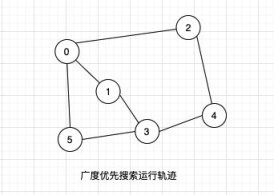吐血整理程序员必读书单:https://github.com/silently9527/ProgrammerBooks
微信公众号:贝塔学 Java
前言
在前面两篇中我们通过深度优先搜索可以从图中找出一条通过顶点 v 到顶点 w 的路径,但是深度优先搜索与顶点的输入有很大的关系,找出来的路径也不一定是最短的,通常情况下我们很多时候需要找出图中的最短路径,比如:地图功能。这里我们就需要使用到广度优先搜索算法
广度优先搜索
依然使用之前定义的寻找路径的 API
public class Paths { Paths(Graph graph, int s); boolean hasPathTo(int v); //判断出从s->v是否存在路径 Iterable<Integer> pathTo(int v); //如果存在路径,返回路径}
复制代码
在广度优先搜索中,为了找出最短路径,我们需要按照起点的顺序来遍历所有的顶点,而不在是使用递归来实现;算法的思路:
使用队列来保存已经被标记过但是邻接表还未被遍历过的顶点
取出队列中的下一个顶点 v 并标记它
将 v 相邻的所有未被标记的顶点加入到队列
在该算法中,为了保存路径,我们依然需要使用一个边的数组 edgeTo[],用一颗父链树来表示根节点到所有连通顶点的最短路径。
public class BreadthFirstPaths { private boolean marked[]; private int[] edgeTo; private int s; private Queue<Integer> queue = new LinkedListQueue<>();
public BreadthFirstPaths(Graph graph, int s) { this.s = s; this.marked = new boolean[graph.V()]; this.edgeTo = new int[graph.V()];
bfs(graph, s); }
private void bfs(Graph graph, int s) { this.marked[s] = true; this.queue.enqueue(s); while (!this.queue.isEmpty()) { Integer v = this.queue.dequeue(); for (int w : graph.adj(v)) { if (!this.marked[w]) { this.marked[w] = true; this.edgeTo[w] = v; this.queue.enqueue(w); } } }
}
public boolean hasPathTo(int v) { return this.marked[v]; }
public Iterable<Integer> pathTo(int v) { if (!hasPathTo(v)) { throw new IllegalStateException("s不能到达v"); } Stack<Integer> stack = new LinkedListStack<>(); stack.push(v); while (edgeTo[v] != s) { stack.push(edgeTo[v]); v = edgeTo[v]; } stack.push(s); return stack; }}
复制代码
以下图为列,来看看广度优先搜索的运行轨迹
单元测试的代码:
@Testpublic void test() { Graph graph = new Graph(8); graph.addEdge(0, 1); graph.addEdge(0, 2); graph.addEdge(0, 5); graph.addEdge(1, 3); graph.addEdge(2, 4); graph.addEdge(4, 3); graph.addEdge(5, 3); graph.addEdge(6, 7);
BreadthFirstPaths paths = new BreadthFirstPaths(graph, 0); System.out.println(paths.hasPathTo(5)); System.out.println(paths.hasPathTo(2)); System.out.println(paths.hasPathTo(6));
paths.pathTo(5).forEach(System.out::print); System.out.println(); paths.pathTo(4).forEach(System.out::print); System.out.println(); paths.pathTo(2).forEach(System.out::print); System.out.println(); paths.pathTo(3).forEach(System.out::print);
}
复制代码
执行的结果与我们分析的运行轨迹一致
符号图
最近几篇文章一起学习到的图算法都是以数字作为了顶点,是因为数字来实现这些算法会非常的简洁方便,但是在实际的场景中,通常都是使用的字符作为顶点而非数字,比如:地图上的位置、电影与演员的关系。
为了满足实际的场景,我们只需要在数字与字符串的关系做一个映射,此时我们会想到之前文章实现的 map(通过二叉树实现 map、红黑树实现 map、哈希表实现 map 等等,有兴趣的同学可以去翻翻),使用 Map 来维护字符串和数字的映射关系。
public interface SymbolGraph { boolean contains(String key); //判断是否存在顶点
int index(String key); //通过名称返回对应的数字顶点
String name(int v); //通过数字顶点返回对应的字符名称
Graph graph();}
复制代码
实现的思路:
使用 Map 来保存字符串-数字的映射,key 为字符串,value 为数字
使用一个数组来反向映射数字-字符串,数组的下标对应数字顶点,值对应字符串名称
假设构造图的顶点与边是通过字符串来表示的,如:a,b,c,d\nb,a,h,l,p\ng,s,z 使用\n 分隔的每段第一个字符串表示顶点 v,后面的表示与顶点 v 相连的相邻顶点;
实际的过程可以根据具体情况来确定,不一定非得这种字符串,可以来源于数据库,也可以来源于网路的请求。
代码实现如下:
public class SymbolGraph { private Map<String, Integer> map = new RedBlack23RedBlackTreeMap<>(); private String[] keys; private Graph graph;
public SymbolGraph(String text) { Arrays.stream(text.split("\n")).forEach(line -> { String[] split = line.split(","); for (int i = 0; i < split.length; i++) { map.put(split[i], i); } });
this.keys = new String[map.size()]; map.keys().forEach(key -> { this.keys[this.map.get(key)] = key; });
this.graph = new Graph(this.keys.length); Arrays.stream(text.split("\n")).forEach(line -> { String[] split = line.split(","); int v = this.map.get(split[0]); for (int i = 1; i < split.length; i++) { this.graph.addEdge(v, this.map.get(split[i])); } }); }
public boolean contains(String key) { return map.contains(key); }
public int index(String key) { return map.get(key); }
public String name(int index) { return this.keys[index]; }
public Graph graph() { return this.graph; }
public static void main(String[] args) { System.out.println(Arrays.toString("323\n2323".split("\n"))); }}
复制代码
文中所有源码已放入到了 github 仓库:https://github.com/silently9527/JavaCore
最后(点关注,不迷路)
文中或许会存在或多或少的不足、错误之处,有建议或者意见也非常欢迎大家在评论交流。
最后,写作不易,请不要白嫖我哟,希望朋友们可以点赞评论关注三连,因为这些就是我分享的全部动力来源🙏
















评论